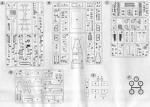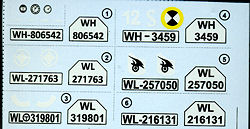
| KIT #: | MB35161 |
| PRICE: | $55.00 MSRP |
| DECALS: | Six options |
| REVIEWER: | Scott Van Aken |
| NOTES: |

| HISTORY |
Mercedes-Benz W136 is the name, using the manufacturer's works number, under which the car is frequently known in retrospect, but the car introduced early in 1936 was known as the Mercedes-Benz 170V. It replaced the six cylinder Mercedes-Benz W15, which at the time had also been known as the Mercedes-Benz 170. Despite having a similar engine capacity of 1.7 litres, the new car's four cylinder unit was more powerful. Technically and stylistically it was far more modern and could be sold at a lower price. Between 1936 over 75,000 were built making it by far the most popular Mercedes-Benz model up till that point.
The "V" in the 170V's name was short for "Vorn" (front) and differentiated the car from the contemporary Mercedes-Benz 170H (where "H" was short for "Heck" or rear) which used the same four cylinder 1697cc engine, but positioned at the back of the car.
Claimed maximum power output was 28 kW (38 PS) at 3,400, using a compression ratio (during the car's early years) of 6:1. The side-valve four cylinder engine consumed fuel at the rate of less than 10 litres per 100 kilometres (28 mpg-imp; 24 mpg-US). The motor was attached using just two mountings and ran with a smoothness hitherto unknown in a four cylinder unit.
Power was delivered to the rear wheels via a four speed manual transmission which initially came with synchromesh only on the top two ratios. However, in 1940 the transmission was upgraded after which synchromesh was incorporated for all four forward ratios.
The VK was the type produced for the Army as a staff car with production running from 1938 to 1942 and producing around 29,000 vehicles. It was also widely used as a police vehicle, in which case it was frequently operated without a top or doors to allow quick exit from the vehicle when rounding up suspects.
| THE KIT |
 One thing I will say about Master Box is that they give you a very detailed kit. This one looks to have well over a hundred parts, many of them, like door handles and gear shift levers are quite small. However, that is generally what you need to have in order to provide the sort of detail that modelers want.
One thing I will say about Master Box is that they give you a very detailed kit. This one looks to have well over a hundred parts, many of them, like door handles and gear shift levers are quite small. However, that is generally what you need to have in order to provide the sort of detail that modelers want.
This is, of course, based on their earlier sedan so you get the same well detailed engine, the same well detailed chassis and suspension and the rubber/vinyl tires of the earlier kit. What is new on this one is the body. In this instance, Master Box has provided a multitude of options in terms of how you can portray this car.
One of the options provided is to have the bonnet open or closed. This is a four piece assembly and to have it open, you need to glue two of the panels differently. Another rather interesting option is to have not only the standard grille, but one with a blanket for the front. This was used when operating in cold temperatures to allow the engine to reach operating temps. This is shown on the box art, but you can be sure a regular grille is provided. As this is a soft top, the windscreen can be modeled flat against the hood. Of course, this would need to be done in the top down option. However, even when up, the driver's portion can be posed open. This is hinged at the top, just like the windscreens on old VW transporters.
Another option is to have the side curtains installed or removed. For those who have never ridden in or owned a car with side curtains, these are either glass or Plexiglas in a metal frame that simply install atop the door. To 'roll down the windows' one removes the side curtain completely. My father's Austin Healey 100-4 had these and they were drafty and leaked! To go with this, the doors can be left off as well, or the intrepid modeler can pose them open.
 What Masterbox has done with this kit is to add five figures. Two are US soldiers asking directions and the other three are civilians who have apparently hitched a ride with the soldiers who have also appropriated the German staff car. Or it could be that the civilians appropriated the staff car. Who knows. What it does mean is that you get five figures and can pose them as it is shown on the box art.
What Masterbox has done with this kit is to add five figures. Two are US soldiers asking directions and the other three are civilians who have apparently hitched a ride with the soldiers who have also appropriated the German staff car. Or it could be that the civilians appropriated the staff car. Who knows. What it does mean is that you get five figures and can pose them as it is shown on the box art.
 The well drawn construction steps are divided into three sections. There are nine steps for the engine, 23 for the frame and suspension, with 38 for the body and final assembly. The painting guide is on the back of the box with the information on painting and assembling the figures. Your options are pretty open in terms of paint schemes. Apparently you just stick on the decals that you want onto the scheme that you choose. The decal sheet itself is nicely done and gives you six different license and badge options. You will also notice that it provides instrument decals for the dash.
The well drawn construction steps are divided into three sections. There are nine steps for the engine, 23 for the frame and suspension, with 38 for the body and final assembly. The painting guide is on the back of the box with the information on painting and assembling the figures. Your options are pretty open in terms of paint schemes. Apparently you just stick on the decals that you want onto the scheme that you choose. The decal sheet itself is nicely done and gives you six different license and badge options. You will also notice that it provides instrument decals for the dash.
| CONCLUSIONS |
A nicely done kit and one that offers the bonus of additional figures. You could easily use the figures and car in separate dioramas. Either way, it is a nice kit and will build into a nice model when done.
| REFERENCES |
http://en.wikipedia.org/wiki/Mercedes-Benz_W136
December 2014
Thanks to www.dragonmodelsusa.com for the preview kit. You can find this kit at your favorite hobby shop or on-line retailer.
If you would like your product reviewed fairly and fairly quickly, please contactthe editor or see other details in the